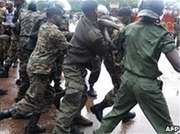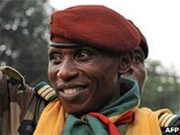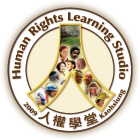
The report says the military tried to cover up the massacre

Human Rights Watch says Guinea's leader should face trial |
 Guinea leader 'should be tried for massacre' - HRW Guinea leader 'should be tried for massacre' - HRW
Guinea's military leader Capt Moussa Dadis Camara could be held responsible for the massacre of 157 protesters in in September, a report says.
The Human Rights Watch report says the killings were designed to silence opposition to military rule. The authors say Guinea's presidential guard fired into the crowd until they ran out of bullets. Capt Camara has previously blamed the deaths on "out of control" elements in the military.
The junta has said that 57 people died - and most of these were trampled underfoot, rather than shot. The Human Rights Watch report says the military tried to cover up the massacre by removing bodies from hospital for secret mass burials. They say this was a crime against humanity, coming under the jurisdiction of the International Criminal Court.
The report names several military officers, including the current head of state, Capt Camara, who it says should be investigated further and face trial. He is currently undergoing hospital treatment in Morocco after being shot by one of his aides.
The aide, Lt Toumba Diakite, on Wednesday said he had shot Capt Camara, because the military leader was trying to blame him for the massacre. Premeditated The report accuses the officers of direct involvement in the killings, or for having command responsibility for the actions of their juniors.
Human Rights Watch Emergencies Director Peter Bouckaert said: "The serious abuses carried out in Guinea on September 28 were clearly not the actions of a group of rogue, undisciplined soldiers, as the Guinean government contends.
"They were premeditated, and top-level leaders must at the very least have been aware of what was being planned, our investigation shows." The report was based on interviews with 240 people - including victims, witnesses, members of the military and diplomats.
The New York-based rights group says between 150 and 200 people were killed and 1,400 were injured during the massacre. Dozens of women were raped. Information Minister Idriss Cherif rejected attempts to apportion blame for the deaths, saying Guinea and the UN had begun investigations.
"I was under 10 dead people, piled on top of me. They moved the bodies to get me out, and I saw I was burned all over my body," she said. A 30-year-old businesswoman who says she was herself raped by two soldiers on the stadium field described seeing a young woman, named in the report as K, raped and then shot point-blank in the head.
"In between the first one raping me and the second, K was killed. I saw the soldier who had been raping her get up, take his gun, and shoot her in the head." The military took over in Guinea after the death of long-time leader Lansana Conte last December, but their rule has been characterised by instability and violent crackdowns on dissent.
(BBC News) |






